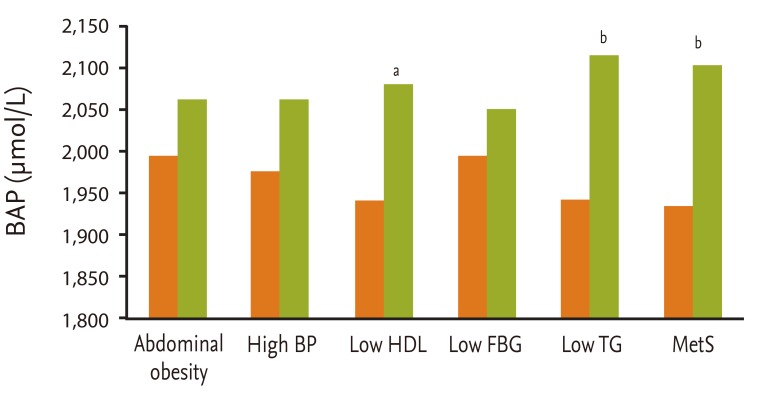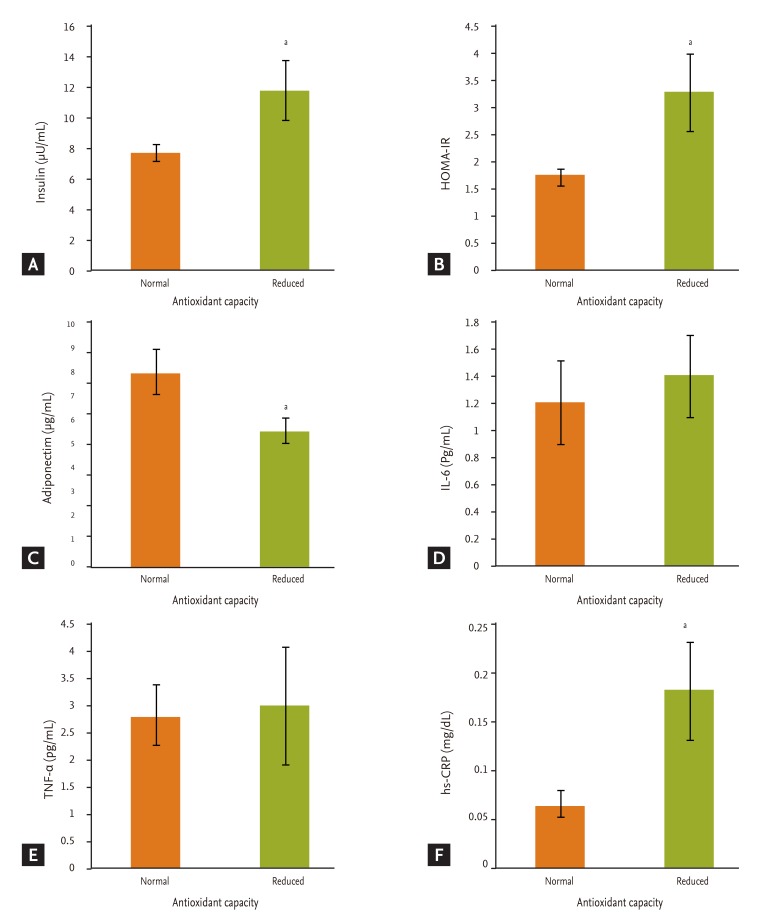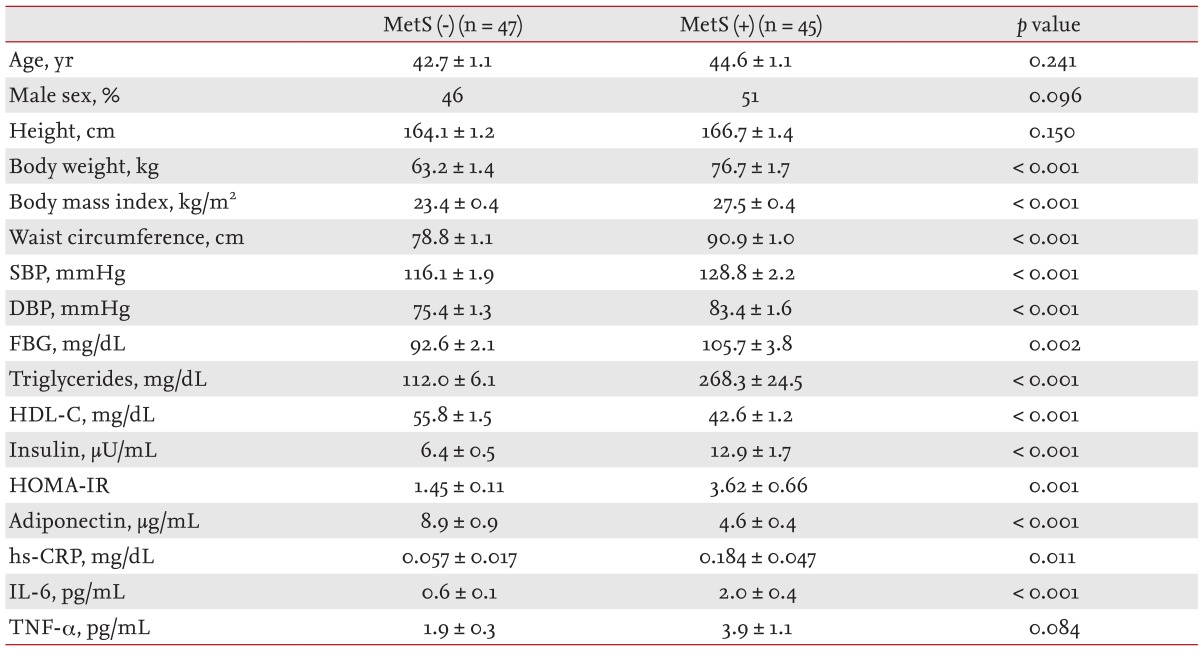3. Ko KS, Rhee BD. Insulin resistance and metabolic syndrome. J Korean Diabetes Assoc 2005;29:501–506.
4. Mohamed-Ali V, Goodrick S, Rawesh A, et al. Subcutaneous adipose tissue releases interleukin-6, but not tumor necrosis factor-alpha, in vivo. J Clin Endocrinol Metab 1997;82:4196–4200PMID : 9398739.


5. Hotamisligil GS, Shargill NS, Spiegelman BM. Adipose expression of tumor necrosis factor-alpha: direct role in obesity-linked insulin resistance. Science 1993;259:87–91PMID : 7678183.


6. Baumann H, Gauldie J. The acute phase response. Immunol Today 1994;15:74–80PMID : 7512342.


7. Imperatore G, Riccardi G, Iovine C, Rivellese AA, Vaccaro O. Plasma fibrinogen: a new factor of the metabolic syndrome: a population-based study. Diabetes Care 1998;21:649–654PMID : 9571358.


8. Rifai N. High-sensitivity C-reactive protein: a useful marker for cardiovascular disease risk prediction and the metabolic syndrome. Clin Chem 2005;51:504–505PMID : 15738514.


9. Lee WY, Park JS, Sung KC, et al. Relationship between metabolic syndrome, insulin resistance and C-reactive protein in urban Korean adult population. Korean J Med 2003;64:169–177.
10. Matsuzawa Y, Funahashi T, Kihara S, Shimomura I. Adiponectin and metabolic syndrome. Arterioscler Thromb Vasc Biol 2004;24:29–33PMID : 14551151.


11. Schafer FQ, Buettner GR. Redox environment of the cell as viewed through the redox state of the glutathione disulfide/glutathione couple. Free Radic Biol Med 2001;30:1191–1212PMID : 11368918.


13. Roberts CK, Sindhu KK. Oxidative stress and metabolic syndrome. Life Sci 2009;84:705–712PMID : 19281826.


14. Ford ES, Mokdad AH, Giles WH, Brown DW. The metabolic syndrome and antioxidant concentrations: findings from the Third National Health and Nutrition Examination Survey. Diabetes 2003;52:2346–2352PMID : 12941775.


16. Skalicky J, Muzakova V, Kandar R, Meloun M, Rousar T, Palicka V. Evaluation of oxidative stress and inflammation in obese adults with metabolic syndrome. Clin Chem Lab Med 2008;46:499–505PMID : 18298345.


18. Eugenio LI. Fundamental principles, signif icance and clinical application of oxidative stress assessment (d-ROMs, BAP and other Carratelli's panel test) Paper presented at: The 1st Korea Free Radicals and Antioxidants Seminar. 2011 Sep 18; Incheon, Korea.
19. Lee SY, Park HS, Kim DJ, et al. Appropriate waist circumference cutoff points for central obesity in Korean adults. Diabetes Res Clin Pract 2007;75:72–80PMID : 16735075.


20. Vassalle C, Pratali L, Boni C, Mercuri A, Ndreu R. An oxidative stress score as a combined measure of the pro-oxidant and anti-oxidant counterparts in patients with coronary artery disease. Clin Biochem 2008;41:1162–1167PMID : 18692492.


21. Hansel B, Giral P, Nobecourt E, et al. Metabolic syndrome is associated with elevated oxidative stress and dysfunctional dense high-density lipoprotein particles displaying impaired antioxidative activity. J Clin Endocrinol Metab 2004;89:4963–4971PMID : 15472192.


22. Vekic J, Kotur-Stevuljevic J, Zeljkovic A, Stefanovic A, Bogavac-Stanojevic N, Vujovic A. Oxidative stress, HDL and atherosclerosis. Antiinflamm Antiallergy Agents Med Chem 2008;7:158–165.

23. Miri R, Saadati H, Ardi P, Firuzi O. Alterations in oxidative stress biomarkers associated with mild hyperlipidemia and smoking. Food Chem Toxicol 2012;50:920–926PMID : 22227215.


24. Abdilla N, Tormo MC, Fabia MJ, Chaves FJ, Saez G, Redon J. Impact of the components of metabolic syndrome on oxidative stress and enzymatic antioxidant activity in essential hypertension. J Hum Hypertens 2007;21:68–75PMID : 17066087.


25. Chaves FJ, Mansego ML, Blesa S, et al. Inadequate cytoplasmic antioxidant enzymes response contributes to the oxidative stress in human hypertension. Am J Hypertens 2007;20:62–69PMID : 17198913.


26. Ikebuchi M, Nishio Y, Maegawa H, Kashiwagi A. Effects of hyperglycemia on oxidative stress and antioxidant potential in patients with type 2 diabetes. Diabetol Int 2010;1:72–77.

27. Ridker PM, Wilson PW, Grundy SM. Should C-reactive protein be added to metabolic syndrome and to assessment of global cardiovascular risk? Circulation 2004;109:2818–2825PMID : 15197153.


28. Bahceci M, Gokalp D, Bahceci S, Tuzcu A, Atmaca S, Arikan S. The correlation between adiposity and adiponectin, tumor necrosis factor alpha, interleukin-6 and high sensitivity C-reactive protein levels: is adipocyte size associated with inflammation in adults? J Endocrinol Invest 2007;30:210–214PMID : 17505154.


29. You T, Nicklas BJ, Ding J, et al. The metabolic syndrome is associated with circulating adipokines in older adults across a wide range of adiposity. J Gerontol A Biol Sci Med Sci 2008;63:414–419PMID : 18426966.


31. Katsuki A, Suematsu M, Gabazza EC, et al. Increased oxidative stress is associated with decreased circulating levels of adiponectin in Japanese metabolically obese, normal-weight men with normal glucose tolerance. Diabetes Res Clin Pract 2006;73:310–314PMID : 16631275.


32. Vassalle C, Masini S, Carpeggiani C, L'Abbate A, Boni C, Zucchelli GC. In vivo total antioxidant capacity: comparison of two different analytical methods. Clin Chem Lab Med 2004;42:84–89PMID : 15061386.












 PDF Links
PDF Links PubReader
PubReader ePub Link
ePub Link Full text via DOI
Full text via DOI Download Citation
Download Citation Print
Print



